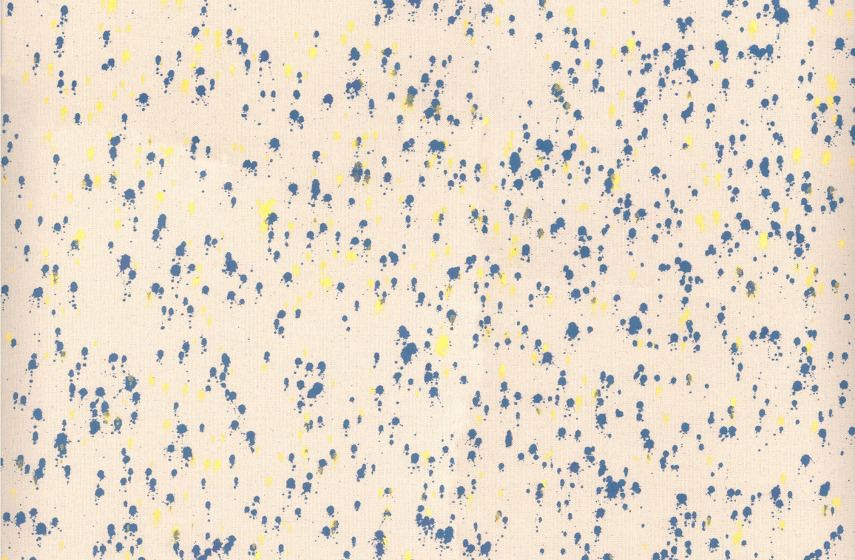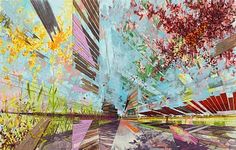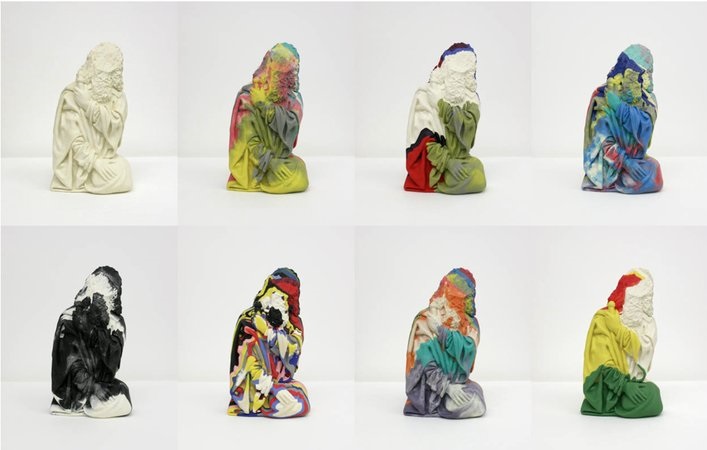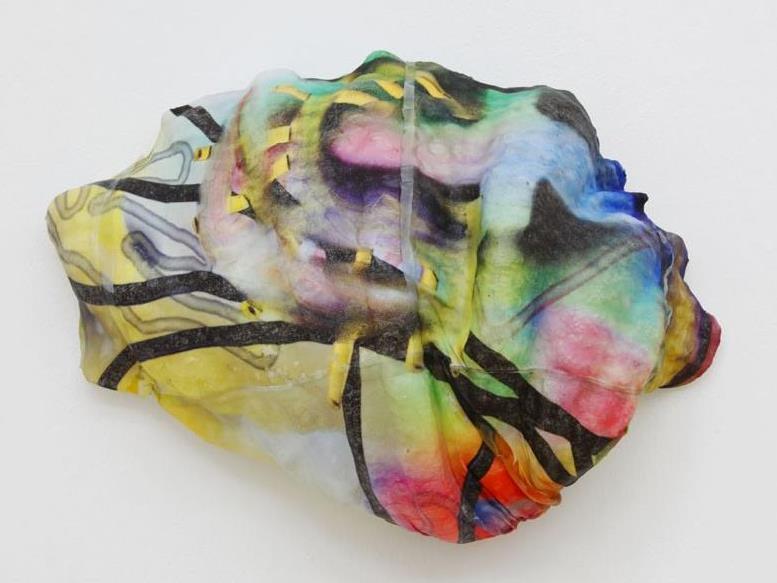Aude Pariset, FX Tridacna (tumblr_lelsnbYMai1qcwgja.jpg), 2011-2013, Inkjet print on rice paper wrappers, from Post-Internet Art.
We are used to learning art history in movements: Modernism, Impressionism, Abstract Expressionism and so on. But while history can be rattled off with a knowing shorthand, things tended to get muddled hen it comes to contemporary art.
The very term – art movement – had become antiquated; academics, curators and artists alike reeling from the thought of being packaged up with others, or defined so succinctly. Even the notion of being part of a trend, or labeled as such, had become the antithesis of the über hip of movement now.
But labels die hard. Recently, there have been a number of “isms” that have been used to describe stylistic similarities or new concepts. Here are some art movements that have surfaced in the past decade. Whether they will become 21st century movements or footnotes to history is yet to be determined.

Lucien Smith, Rain-Painting
Zombie Formalism
The famed American critic and art historian Walter Robinson coined the term Zombie Formalism to describe a revival of 20th Century aesthetics and a backward-looking idea of originaity.
He calls it “formalism” ‘because this art involves a straightforward, reductive, essentialist method of making a painting’ and “Zombie” ‘because it brings back to life the discarded aesthetics of Clement Greenberg, the man who championed Jackson Pollock, Morris Louis, and Frank Stella’s “black paintings,” among other things’.
Zombie Formalism dwells in the realm of the echo, believing that “real” originality can be found only in the past. So, given that position, Zombie Formalism celebrates new “firsts”, artificial milestones that appeal to our sense of value for the “new”. Robinson cites as examples the first-ever painting made with the electroplating process by Jacob Kassay and the first-ever painting done using paint applied in a fire extinguisher by Lucien Smith.
Will it last, and indeed is it real, to use Robinson’s own penchant for discourse? He believes so: ‘At any rate, like the creatures of its namesake, Zombie Formalism pops up all over the place.’ Time will be the true arbiter.

Image: Bejing Posthastism
Posthastism
Another celebrity of the art world, Swiss curator and co-director of London’s Serpentine Gallery, Han Ulrich Obrist, claimed a new art movement which he labelled Posthastism. Like the Slow Movement, which celebrates food, culture and travel which slows down and luxuriates in the present, posthastism seeks to overcome the rush of modernity.
‘I’m interested in resisting the homogenization of time: so it’s a matter of making it faster and slower,’ he said in a 2011 interview where he introduced the movement, which he formed with writer Shumon Basar and designer Joseph Grima.
The movement has since produced a manifesto which celebrates such as activities as sleep, slow dancing and galactic time, in which even the speed of light is slow. An exhibition Bejing Posthastism investigated how individuals’ daily practices response to the hectic and deteriorated environment, both physical and virtual.

David Schnell, Audiopleasures, Image via Pinterest
The New Leipzig School
Surfacing with new millennium in 2000, was a loose movement of painters and sculptors emerging out of the Academy of Visual Arts in Leipzig, East Germany, come to be known as the New Leipzig School or Neue Leipziger Schule, but more colloquially known as Young German Artists (YGAs). After re-unification in 1989, the school opened up to the West, as did a market for their work. The first successful artist to emerge was Neo Rauch, who the savvy New York dealer David Zwirner Gallery picked up and gave a solo exhibition to in 2000.
The style of the YGAs of New Leipzig School is ‘typically figurative with a strong emphasis on narrative, and is characterized by muted colours… the use of grids, colour theory, and the laws of perspective.’ It comes from traditionalist teaching practices yet with a passion for new narratives.
Social Practice
Social Practice is a term used to describe a group artists who have a commitment to work collaboratively through social formats to emphasising and effecting change. Working across media social practice as the primary art form occurs in two formats: activity and inquiry. It has also been referred to as new-genre public art, community art, interventionist art, dialogical aesthetics,and participatory art. Key is the idea of involving others in a process of dialogue or inter-action as the art work (as opposed to its mere process).
The California College of the Arts in San Francisco first used the term in 2005 to define a new MFA program in social practice. The movement spawned The Social Practice Arts Research Centre (SPARC) at the University of California, Santa Cruz and a global trend towards cultural partnerships and community practices. Among them was the Centre for Community Partnerships at the University of Melbourne, now controversially facing closure.
Read: University can’t afford art with a conscience

Oliver Laric, Icon (Utrecht)
Post-internet art
Art Post-Internet takes its name from a 2014 exhibition at Ullens Center for Contemporary Art in Beijing organised by critic/curator Karen Archey and writer/gallerist Robin Peckham. The exhibition took art that is usually only available online and used it as a tool for comment on ‘real’ life.
Post-internet is concerned with the way online images define our culture and the new relationship between image and objects that is a result of the variability and ubiquity of the online image. A cat urn, computer assisted drawings, mash-ups and a new relationship between art and branding are among the early threads in what promises to be a burgeoning movement.
Craftivism
Probably most widely recognised for its popular tangent – yarn bombing – Craftivism is essentially the combination of Craft and Activism. The term first gained traction in 2003, and took on a predominantly guerrilla style art event, where craftivists would occupy a site for a “knit-in” for example, street pole cozies or wool-clad handrails, to cross-stitched political messages placed in public spaces. Some of the groups that emerged were Knitta and the Crafivist Collective. The movement started to divide in 2009, when some artists took a stronger political position in their actions and making, while for others – landing the term the “Etsyians” from the e-commerce Etsy site – said that buying and selling directly from the maker was challenge enough of corporate culture.
Gifism
Graphics Interchange Format, or the GIF, has been around since 1997 but in the last decade it has become a force within digital media and with 3D animators. It is technology that allows short animations to be loaded and shared easily online, and with a proliferation of exhibitions of GIF art and online anthologies collecting examples, it has earned the title as an art form, or art movement.
The two-person artist collective MTAA released a GIF to the public domain in 1997 for remixing and as an invitation to join a dialogue. The next wave was speared by Rhizome, who commissioned artists to produce splash pages for its website between 1998 and 2002. Paddy Johnson writes: ‘The year 2003 was a busy one for the animated GIF. MySpace was founded that year and quickly became a platform that was for the dissemination and exchanging of GIFs.’ She continued: ‘Let’s face it, after about 2009 GIF production accelerated at such a rate that any attempt to identify key artists would not only be futile, but create a post so long no one would read it.’ With the invention of Tumblr in 2007, GIF Art exploded; over the years its social media capacity to share and an increased file size for GIFs has allowed this form of art expression to move into a creative art movement.
Yellowism
7 October 2010, Vladimir Umanets walked into Tate Modern and tagged Mark Rothko’s painting Black on Maroon with the words “a potential act of yellowism”. While the artist/vandal was jailed for two-years, his message continued to perplex the art world. Umanets, and partner Marcin Lodyga, used the action as a call to a new art movement “yellowism”, declaring in their manifesto: ‘examples of Yellowism can look like works of art, but are not works of art … pieces of Yellowism are only about yellow and nothing more. All manifestations of Yellowism have the same sense and meaning and express exactly the same. In Yellowism, all the possible interpretations are reduced to one — are equalized, flattened to yellow.’
Purportedly, the movement began with an exhibition in Egypt in November 2010, its title “Flattened to Yellow”, pathing the way for a surprising visible and debated art movement that blazed bright (or yellow) then faded to insignificance.
Viral Activism
This term refers to art work or actions created specifically to use social media to extend, complete, or discuss a topic. Using the Internet as a performative community, the desire it that these artistic expressions are rehashed, reposted, regurgitated to the point that they go “viral”. An artists might stage a performative piece with the intention of being photographed on a smart phone, commented on and posted – usurping the social networking frame of others to disseminated that art. Key to this emerging art movement is its social or political angle to expose or extend a dialogue on a topic relevant to news of the moment. The intended audience is online and the intended time frame is now.
Read: Viral Activism as a new movement
Stuckism
It is said that the term comes from an insult British artist Tracey Emin delivered at artist Billy Childish in 1999, stating that his art was “stuck” in the past. Working in a more painterly way, largely rejecting “Brit Art” and the conceptual drive that dominated the 90s, Childish, along with Charles Thomson founded Stuckism, endorsed by eleven fellow artists. A new movement had been borne.
It has been reported that the group held numerous exhibitions in Britain during the early 2000s, including “The First Art Show of the New Millennium” (January 2000), and several annual shows entitled “The Real Turner Prize Show”. The group also showed in Paris, Hamburg, Cologne, Leipzig, New Jersey, New Haven (USA) and Melbourne Australia. Stuckism as an art movement was featured in two books: “Styles, Schools and Movements: an Encyclopaedic Guide to Modern Art,” by Amy Dempsey and “The Tastemakers: UK Art Now,” by Rosie Millard. A Stuckist gallery was also opened in central London. Members of the Stuckist group included, among others, Charles Thomson, Billy Childish, Bill Lewis, Philip Absolon, Sanchia Lewis, Sheila Clark, Ella Guru, and Joe Machine.
Type Motion
Text art has been around since the early 20th century but several exhibitions in recent years have corralled new modes of exploring test in our digital age. In 2013 the important Germany gallery ZKM Museum of Contemporary Art presented the exhibition TYPEMOTION, The museum states: ‘Through multiple digital possibilities, type and image have become unmistakably mobile. We are contemporary witnesses to a massive transformation. Reinforced by its function in the mediation of information, type can go beyond its function in the mediation of information. Type is increasingly gaining an autonomous, aesthetic status.’
This article was edited for republication in October 2016





